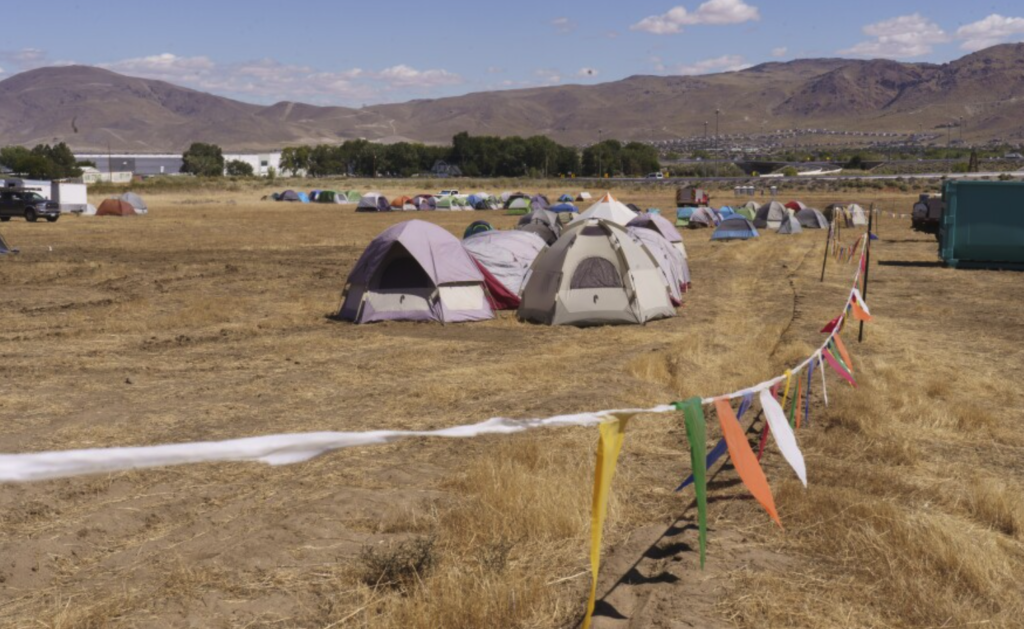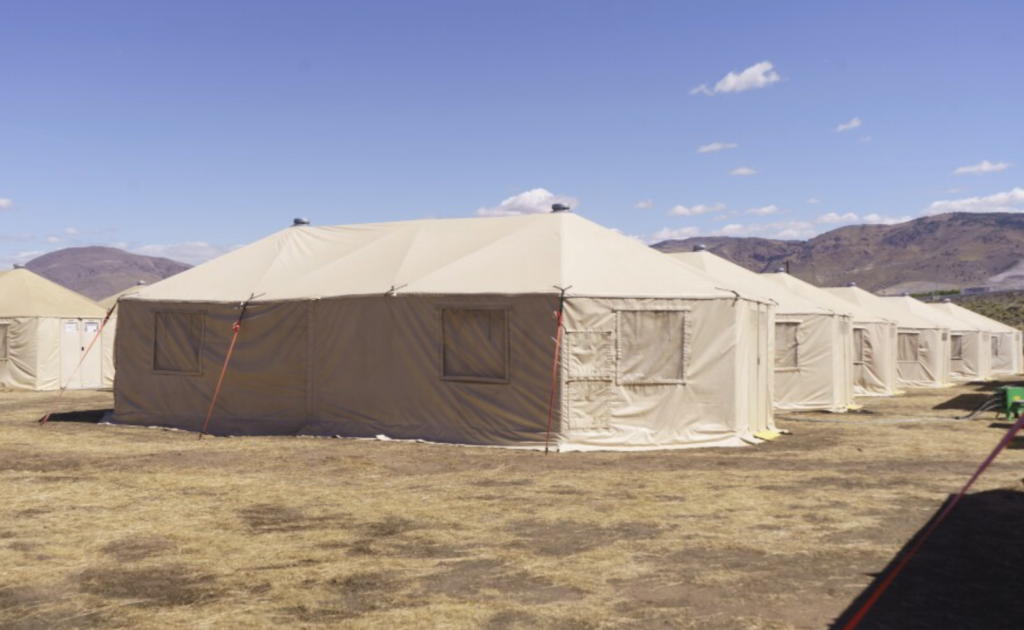Above: Marya Washburn is pictured standing in front of tents acting as offices in the Davis fire incident command in South Reno.
This story was shared with permission from KUNR Public Radio. For an audio version of the story, please visit the KUNR website.
When a wildland fire breaks out, it requires a staggering amount of resources and logistics to fight – the Davis fire that burned south of Reno in September was no exception.
Over the sounds of the nearby highway, two sets of footsteps crunched over an open dirt lot in south Reno where seemingly overnight a miniature city of tents and trailers sprang up.
Marya Washburn, a public information officer, and I walked between rows of large, tan tents that matched the color of the dirt underfoot. This pop-up camp acted as the incident command center for the Davis fire, and was a home base for some of the over 600 personnel who flooded in from across the country to help fight the blaze.
“This camp has everything that folks need – where they can sleep at night, where they can have showers, where they can get food, there’s hand washing stations, there’s all the supplies [there]. And so we set it up so we can be self-sufficient and have people get their needs met,” Washburn said.
In an adjacent field were clusters of smaller camping tents – a place for some of the hardworking firefighters to get a moment of reprieve and hopefully, some sleep, between long hours on the fireline.
This incident command base also acted as an informational hub and planning center. The larger tents, or yurts, as Washburn called them, became offices where map-making, weather forecasting and logistics to fight the fire were all planned out at all hours of the day and night.
“We’ll do our morning briefings and our evening briefings there. So people have the idea of what’s happening during the day and what they’re going out to do,” Washburn said.


When wildland fires like the Davis fire break out they often require more resources than local fire agencies can provide. This is where the National Interagency Coordination Center, or NICC, comes in to mobilize and dispatch resources from across the country to areas where aid is needed.
Washburn herself was mobilized to come here from her home in Colorado as part of the Complex Incident Management Team, Southwest Team One.
“Complex teams come in when there is an incident that’s gone above the capacity of the local agency and the local area to be able to manage. And it doesn’t mean that the local area doesn’t have the skills. It’s really a matter of numbers and operational abilities,” Washburn said.
She explained that it is not expected for every town or region to have enough resources to fight large wildland fires, and that it takes a large interagency effort to fight blazes like the Davis fire.
Washburn said she got the call that Southwest Team One was being deployed to the Davis fire a day after it broke out – and by the following evening, they had taken over management of the fire.
“We sort of show in as that middle management level to help get operations and logistics and public information and supplies all rolling for those local folks and those firefighters on the ground, so that the local agencies can still do their jobs here, because these are their communities,” Washburn said.
Southwest Team One was the only team available when the need for a team came up nationally, and any closer agencies and resources were already in use on other fires across the West and the country or taking a much needed rest after just coming off of a fire.
“For us with fire response, we’re currently at preparedness level five, which is the highest level you can get to, and it means that resources across the country, we are pretty taxed,” Washburn said.


The NICC has a scale of preparedness levels from one to five, that compares the amount of resources available to the amount of resources needed for fire response. Washburn said that being at preparedness level five,“means anyone that can go out, if they have the ability to come out and help, we ask for those folks that can come out and help. “
This meant people were coming from across the country to provide assistance. According to a map released from the Humboldt-Toiyabe US Forest Service’s social media, personnel from as far as Alaska and Florida, and many states in between, joined in the effort to stop the Davis fire. Closer fire agencies within Nevada from as far as Clark County, as well as the local National Guard also deployed to assist with the effort.
The Davis fire was particularly risky due to high winds combined with extremely dry conditions, which led the National Weather Service to issue a Particularly Dangerous Situation Red Flag warning for the area, which was only the sixth time in history this warning had been issued in Reno.
On the day this warning was issued, certain models predicted the fire to move up to seven miles into residential areas of south Reno, but luckily this scenario did not play out and the fire containment lines held.
On Sept. 18, the fire that had burned 5,824 acres was at 92 percent containment and management of the fire transitioned back from Southwest Incident Management Team One to local agencies.
Washburn said Southwest Team One did not want to take credit for stopping the blaze, and instead she credits the hard work of the firefighters on the line and local agencies.
“It’s the firefighters on the ground that helped stop the fire from moving. We’re just here to help make sure everyone stays safe while we’re doing it, and that we’re all on the same page with the plan,” Washburn said.
Kat Fulwider is the 2024 fall intern for KUNR and the Hitchcock Project for Visualizing Science.






